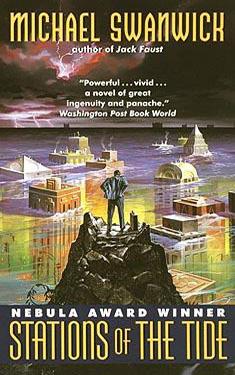Michael Swanwick
Completed 1/18/2021, Reviewed 1/20/2021
2 stars
I
did not like this book. I had a hard time
following the action and reconciling it with what I knew of the plot from the
back cover and the online blurbs. It
felt like it was a series of loosely connected vignettes with a mildly
interesting premise that sort of tied it all together. It had sex scenes which felt gratuitous. The characterization was practically
non-existent. Ultimately, it felt like a
pretentious attempt at cyberpunk crossed with the surreal neo-sci fi of the
late sixties and early seventies
The
plot was thin. It takes place on a
planet whose icecaps melt dramatically every two hundred years, flooding all
but the highest mountains, leaving archipelagos. All the people on the planet are either shipped
off the planet or taken to some “island” refuge. The main character, known only as the bureaucrat,
is on the hunt for a wizard/magician who is using illegal technology. He goes from minor character to minor
character trying to find clues as to his whereabouts. He travels with his trusty briefcase, an AI
that talks to him, acts as sort of a modern phone/tablet, and can sprout legs
and find its way back to him if he is ever stolen.
The planet
is known as Miranda and the plot has many similarities to Shakespeare’s “The
Tempest”, or at least according to other reviewers I’ve read. Although I’ve seen a production of it on Broadway
with Patrick Stewart and a strange film adaptation called Prospero’s Books, I
remember images more than the story. So
the comparison is rather lost on me (I know, shame on me and my lack of knowledge
of classic literature). I’ve also read
that this book has been compared to Joseph Conrad’s “Heart of Darkness”, which
I haven’t read but know some of the premise.
But given all these homages, I didn’t find anything deep or satisfying
about the story at all.
The cyberpunk aspect is realized in that it’s hard to tell reality from the virtual and truth from hallucination. There are android-type things that can take the identity of someone, acting as an agent or a double, making it hard to tell whether you’re dealing with the actual person or not. There are the indigenous creatures of the planet, now mostly extinct, but show up as ghostly, shapeshifting entities known as haunts. They can appear as human or as animals. At one point, the bureaucrat is drugged and has a long hallucination with bursts of reality, complicating matters even more.
I never fully engaged with the bureaucrat, or any of the secondary characters for that matter. The closest I came to liking a character was the witch with whom he has a sexual relationship. I think this was because she drew some realistic emotions out of the bureaucrat.
I
give this book two stars out of five. I
found it a really tough read because of the disjointed episodes of the bureaucrat’s
investigation and because of the androids popping out one, two, and in one case
five copies of individuals. This was a
short book, but reading it was a trudge.
I think I was reading about fifteen pages an hour. I think I read it pretty carefully, but found
no satisfaction in the experience. I
didn’t find any layers of deeper meaning.
It was simply a surreal mess.

No comments:
Post a Comment